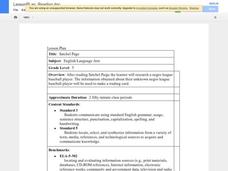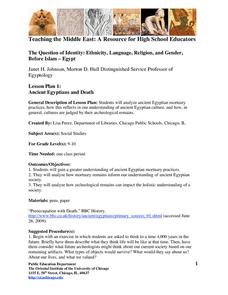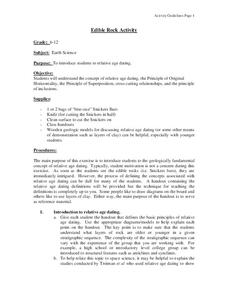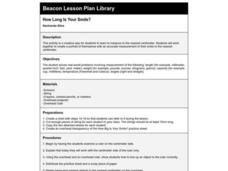Curated OER
Coast-to-Coast Book Design-Part 3: Brainstorming the Book
Students examine the process of designing a book and identify the steps necessary to publish a book. In small groups they analyze ABC books, and discuss the similarities and differences between the books. Students then brainstorm ideas...
Curated OER
Satchel Page
Bring a lesson about Negro League Baseball to your Black history unit, or any other research unit throughout the year. While the lesson plan itself is simplistic, there are several good ideas that you could use, such as creating trading...
Virginia Department of Education
Relationships Round Robin
Mathematics is all about patterns. Young mathematicians analyze geometric patterns to write algebraic expressions. They use the expressions to predict future stages of the patterns.
Curated OER
How Much Water is in That River?
Students practice measurement using the Hudson River. They calculate the discharge measurement at a location on the Hudson River using ingenuity and a topographic map.
University of Chicago
Ancient Egyptians and Death
What archaeological evidence remains of ancient Egyptian burial and mortuary practices, and what can this information tell us about ancient Egyptian society?
Curated OER
Edible Rock Activity
Who knew Snickers® could be used to teach science? Give your budding earth scientists a chance to explore the Law of Superposition, in addition to a well-earned snack.
EngageNY
Exponents
Powered up! Here's a great resource on exponents. Scholars build on their previous understanding of exponents to include all positive real number bases. Distinguishing between an and a^n is a major goal in the fifth lesson of a 36-part...
Alabama Learning Exchange
How Are Rainbows Created?
Students describe how the sun's rays produce colors. They describe how water causes the sun's rays of light to bend, producing a rainbow.
Curated OER
Easy to Read
Learners compare reading passages in paragraph form to book form. They determine that the reading passages on the state assessments are no more difficult than the books they choose to read. They turn their favorite books into reading...
Curated OER
The International Monetary Fund, The World Bank, and the World Trade Organization: A Help or Hindrance to Developing Countries?
Eleventh graders study the International Monetary Fund, World Bank, and World Trade Organization. They collaborate in small groups to research and explore perspectives of each group, identify objectives of each group and key arguments...
Curated OER
How Do I Find Out More About...?
Eighth graders interpret historical evidence presented in primary and secondary resources. In this Era of Good Feelings instructional activity, 8th graders research historical figures of the Antebellum Period. Students use their findings...
Curated OER
How Long Is Your Smile?
Fourth graders measure to the nearest centimeter. They work together to create a portrait of themselves with an accurate measurement of their smile to the nearest centimeter. This is a creative way for students to explore centimeters.
Curated OER
How Would You Spend a Million Dollars?
Pupils plan and organize a theme to spend one million dollars. They select a theme, research prices of items on the Internet, organize the information into a spreadsheet, write an introductory paragraph, and create a final project.
Curated OER
Investigation-How Far Can You Jump?
Students explore measurement. In this math lesson plan, students measure how far they can jump using blocks. Students compare the results when different sized blocks are used. Students estimate the distance jumped.
Curated OER
Learning to Love That Poetry
Second graders listen to the novel, "Love That Dog." students reflect in a journal each day about the poetry form learned that day. They create their own poems following that format and have it for class the next day.
Curated OER
To Be (Half) Or Not To Be (Half)
First graders demonstrate various ways to represent and verify a whole or set separated in two, three, or four equal parts. Using interlocking cubes, Students model a part of a whole or a part of a set. They use appropriate tools and...
Curated OER
Writing a Letter to Johnny Appleseed
Third graders write a letter to Johnny Appleseed describing how they use technology in their daily life and the advantages and disadvantages of using technology.
Curated OER
An Introduction to Collocation
Young scholars listen to text in the form of a letter and then read the same text to determine how collocations can have different meanings. Students listen to a sample of dialogue to understand how the the usages of "make," "do," and...
Curated OER
Journey to Japan: An Elementary Geography Standards-Based Unit on Japan
Second graders compare and contrast Japanese customs and culture to those of Americans through research in this year long study. They determine the basic needs of all people in spite of cultural differences.
Curated OER
An Introduction to Japanese Food
Student explore the local food in Japan. Pupils listen to the teacher's description of Japanese cuisine. In groups, classmates follow recipe instructions to create Miso coup and rice. They discuss the taste of Japanese food as they...
Curated OER
Rocket to Success
Learners investigate action and reaction. In this energy instructional activity, students use a balloon and string to create a simple rocket. The will collect quantitative data record their observations, and relate their...
Curated OER
Bringing Tolerance to Our Beaches (Private-Religious)
Students role play. In this equality instructional activity, students read a passage in Leviticus and describe people that would be considered strangers and how they are to be treated. Students discuss the concept of discrimination....
Curated OER
Weather Instruments
Third graders make predictions about weather and utilize weather instruments and weather reports. They match weather components with weather instruments, and demonstrate how to read a thermometer. Students also construct and use a wind...
Curated OER
Running of the Bulls
Students examine what might be in store for Wall Street following the NASDAQ's 547.57 point plunge on Tuesday, April 4, 2000. They evaluate how they might manage a heavily laden high-tech portfolio before deciding how to invest in the...























